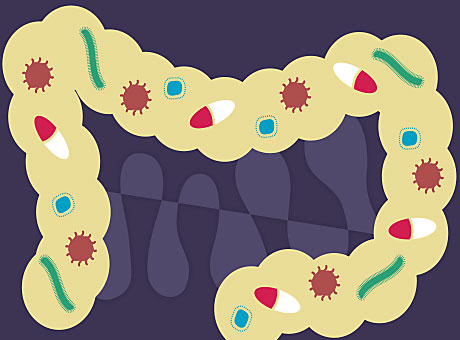
Gut microbes in healthy kids carry antibiotic-resistance genes
Frequent antibiotic exposure accelerates spread of this resistance

Friendly microbes in the intestinal tracts of healthy American children have numerous antibiotic-resistance genes, according to a pilot study by School of Medicine scientists. The genes are cause for concern because they can be shared with harmful microbes, interfering with antibiotic effectiveness in ways that can contribute to serious illness or death.
“From birth to age 5, children receive more antibiotics than during any other five-year time span in their lives,” said senior author Gautam Dantas, PhD, assistant professor of pathology and immunology. “Frequent exposure to antibiotics accelerates the spread of antibiotic resistance. Our research highlights how important it is to only use these drugs when they are truly needed.”
With funding from the Children’s Discovery Institute, the International Center for Advanced Renewable Energy and Sustainability, the National Academies Keck Futures Initiative and the National Institutes of Health (NIH), the researchers analyzed fecal samples from 22 infants and children ages 6 months to 19 years. Phillip I. Tarr, MD, the Melvin E. Carnahan Professor of Pediatrics at the medical school, provided the samples.
— Gautam Dantas, PhD
Despite the small sample size, the analysis identified 2,500 new antibiotic-resistance genes, expanding the list of known antibiotic-resistance genes by more than 30 percent.
“Microbes have been battling each other for millennia, regularly inventing new antibiotic-synthesis genes to kill off rivals and new antibiotic-resistance genes to defend themselves,” Dantas said.
The scientists identified the new resistance genes by testing intestinal microbial DNA from the children against 18 antibiotics. The identified genes impaired the effectiveness of all but four of the drugs.
Babies lack microbes in their intestinal tracts at birth. They establish their communities of gut microbes through ingestion of microorganisms in their environment — from crawling on the floor, for example, to putting toys and other objects into their mouths, to contact with their primary caregivers.
According to the Centers for Disease Control and Prevention, antibiotic-resistant infections cause at least 2 million illnesses and 23,000 deaths annually, adding $20 billion in health-care costs. Methicillin-resistant Staphylococcus aureus now causes more U.S. deaths than HIV. Scientists use the term “resistome“ to refer to the collective antibiotic-resistance genes of a microbial community.
“There were quite a few resistance genes in microbes from every child we looked at,” Dantas said. “This was true even in children who were only 6 months old. When we compared their resistomes to those of older children, there didn’t seem to be much difference.”






